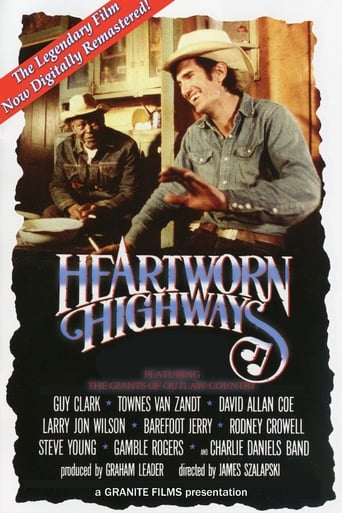reverendtom
This film is about the "outlaw" country music movement of the 70s, when artists rejected the glossy, strings filled Nashville sound and made poignant, gritty music. Guy Clark, David Allen Coe, Charlie Daniels and more are featured. Townes Van Zandt really steals the show, though. Out in his ratty trailer he shown drinking whiskey and shooting bb guns. He sits down in the kitchen and plays some songs for his girlfriend and his elderly black neighbor (whose interactions with Townes are amazing) and plays some of the most amazing music you'll ever hear. There are also some great scenes of a little local ensemble playing in a bar. This is a must-see film for fans of Real Country Music. The pop pablum was crap then and its crap now. Real country will live on.
scully-45
I was fortunate to have been invited to the first screening of Heartworn Highways when it was shown to the New York press in 1981. A young struggling musician at the time, I was mesmerized by the power and soul of these contemporary singer/songwriters. This is what "real" American country music was supposed to be, not the sequin fellas and big haired gals of Nashville. Years later I would have conversations with Guy Clark at the Crow's Nest, a little bar in North Florida frequented by shrimpers and other assorted swamp rats about the "voice" of country music. Who would have believed that these magical music makers would become decades later, the bedrock for today's true country. The director, Jim Szalapski, had been a friend and roommate in my younger days rambling through New York. We lost Jim a couple of years ago and with his passing went the genius that I will be forever grateful to for capturing the soul of American country music. Somewhere on that heartworn highway, Jimmy's still looking out from a Mini-Cooper for a good story to tell. I've waited twenty five years to seen this film again, twenty five years too long.
paul2001sw-1
In 1975, James Szalapski decided to make a film about country music. Instead of going to the big names, he was put in touch, via a mutual acquaintance, with bassist Skinny Dennis, a notorious hell-raiser who left little musical legacy when he died a short while later, but who was much loved by his friends, who included many of the most talented up-and-coming singer songwriters of that time. Among them was Guy Clark, whose house was a meeting place for geniuses such as Townes van Zandt, Steve Young, Rodney Crowell and even Steve Earle, then completely unknown but starting to make his musical career. It's this network, centred on Clark, that occupies the heart of this film. Szalapski films them going about their normal lives: none of them are rich, none of them are famous, and crucially none of them expect to become either of those things by appearing in this film. But their wholly authentic love for their music, and their wholly exceptional abilities, enliven one of the most genuinely intimate (and musically sublime) documentaries you are likely to see. Szapalski also films a selection of other rootsy artists, but it's with Clark and his friends, all utterly obscure at that time, where the film's heart beats loudest. The new DVD contains extra performances cut from the original; many are good in isolation, but it's to Sazpalski's credit that the material he chose for inclusion suits the finished film better than that he omitted. A fine film, and (with Townes now dead) a poignant one as well.
grump-1
James Szalapski's documentary--filmed in 1975, but not shown until several years later--captures a pivotal point in country music when the the glossiness that had taken over the industry gave way to a back-to-basics movement centered in Austin and Nashville. Young songcrafters such as Guy Clark, Townes Van Zandt, Rodney Crowell, Steve Young, and a young Steve Earle are shown in loose, relaxed performances while The Charlie Daniels Band and David Allan Coe are filmed performing at a Texas holiday concert and at Tennessee State Penitentiary, respectively. Along with presenting personal portraits of these artists, Heartworn Highways effectively preserves an image of two very musical cities and their colorful inhabitants as they were in the middle of the artistically fertile 1970s.




